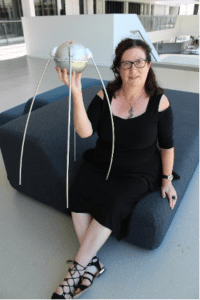By Alice Gorman
SpaceWatch.Global has been granted permission to publish selected articles and texts. This is an extract of “Moonwalking, When other worlds belong to women”, originally published 2 November 2021 in Griffith Review 74: Escape Routes by Alice Gorman

WHAT WILL IT mean for a woman to set foot on the Moon, a world whose human landscape has so far been shaped largely by men? In the twentieth century, twelve men became moonwalkers, their footprints tenuous trace- fossils pressed into the soft, fine lunar dust. One of the most reproduced images from the Apollo 11 Moon landing in 1969 is a single boot print created by Buzz Aldrin showing the striped ridges of the sole: the mark of ‘mankind’ on another world.
Surely the first footprint of a woman will become a similarly celebrated icon, but of the twenty-first century this time. I imagine so many emotions swirling through her head: excitement, fear, pride, the intensity of being inside her own body at that moment. The male crew will have been instructed to let her go first, a space-age variation of the old chivalry where men opened doors for (some) women in deference to their imagined fragility.
She’ll represent all womankind. The Apollo 11 astronauts claimed their mission on behalf of all ‘mankind’, but we know what this really meant. Over millennia and in diverse cultures, men have been the standard of humanity. ‘Mankind’ did not always include women, who were excluded from public life, politics and education in Christian northern hemisphere cultures, their minds supposedly overwhelmed by their leaking, bleeding, bifurcating bodies, governed by the instability of the Moon.
The first woman on the Moon will have to think carefully about her first words, as they will resonate for generations into the future. Neil Armstrong chose his famous ‘one giant leap’ line himself; but in this case, knowing what’s at stake, there’s bound to be a committee who gives this long and considered thought. Social media will repeat her words and circulate her image endlessly, so little will be left to chance.
I imagine her standing there, still for a few moments before she carefully places her second foot beside the first. The rest of the crew will be tasked with taking photographs of her and there will be a camera rolling, sending a live transmission back to Earth. After the thrill of the Apollo 11 astronauts’ first steps, watched by 600 million people around the world, audiences declined with each of the following five missions to the surface. What size audience will she draw, this first woman, this new Eve? There are nearly four billion women on Earth – will they all watch, downlinking the images from the tens of thousands of satellites in the megaconstellations surrounding Earth? Will their fathers, brothers, partners and sons watch too – or will they dismiss this historic moment? This was the case for Soviet cosmonaut Valentina Tereshkova, the first woman to leave Earth in 1963. Six years before ‘man’ went to the Moon, Tereshkova performed what is still today the only solo space mission by a woman, when she orbited Earth forty-eight times over three days – yet even now there are many from both sides of the former Iron Curtain eager to denigrate her achievement as a ‘stunt’.
The grey dust will sink beneath her weight as she steps forward to stride out of the shadow of the lander and stand in the light of the lunar dawn. A lunar day is two weeks long, and temperatures can reach nearly 130 degrees Celsius as noon approaches; but early in the day, the surface hasn’t yet had time to heat up. In any case, she is cocooned in multiple protective layers, like a larva or an ancient Egyptian mummy. She can’t see, touch, taste or hear the Moon except through the prosthetic interface of this suit.
In one-sixth Earth gravity, her body will be lighter. On Earth, men are often associated with ‘gravitas’, whereas women are frequently dismissed as less serious, more flighty. This is until they become ‘gravid’, weighed down and rooted to Earth by child. Menstrual cycles have long been linked culturally to the waxing and waning of the Moon, but seen from the lunar surface, it is Earth that becomes the fickle and changeable one. The social meanings of these natural phenomena depend so much on perspective.
But she is a scientist, and there is work to be done. Soon the wonder of those first lunar moments will be eclipsed by setting up experiments, taking samples, operating robots, and the more mundane work of maintaining her own body with food, sleep and hygiene in this alien environment. As the hours and days go by, she’ll look at the pitch-black sky and then back at Earth, marvelling that she alone of all womankind has left it behind to become interplanetary, walking under the full, unmediated light of the stars.

Alice Gorman is an internationally recognised scholar in the field of space archaeology, and author of the award-winning book Dr Space Junk vs The Universe: Archaeology and the Future (MIT Press, 2019). She is an associate professor at Flinders University and a Vice-Chair of the Global Expert Group on Sustainable Lunar Activities.
This work was first published in Griffith Review 74: Escape Routes (2 November 2021) https://www.griffithreview.com/articles/moonwalking/. Rights reserved – this publication is reproduced with permissions.





